Maltese Small Terrestial Mammals:
Insectivora; Lagomorpha; Rodentia
The first serious attempt to list the Maltese mammalian species
can be dated to 1890. This list however was far from complete and included
a number of mistaken identifications. The small mammals listed in this
work (Gulia, 1890) included the hedgehog [Erinaceus europaeus Linnaeus],
the wild rabbit [Lepus cuniculus Linnaeus], and four species of
rodents [Mus decumanus Linnaeus; Mus alexandrinus Geoffr.;
Mus
musculus Linnaeus; Arvicola amphibius Linnaeus].
Further additions to this list were subsequently made so that in
1969, G. Lanfranco in his reviewed list considered this group of mammals
to be represented by seven confirmed species and four doubtful ones. Further
work by other authors has confirmed the status referred to in the list
below. In addition a number of fossil forms have been excavated from the
Pliestocene deposits of the Islands.
SYSTEMATIC LIST OF REPORTED MALTESE TERRESTIAL SMALL MAMMALIAN SPECIES
Order: LAGOMORPHA
Family: LEPORIDAE
Oryctolagus cuniculus (Linnaeus) s.sp. ? huxley Haeckel
 Wild
Rabbit
Wild
Rabbit
maltese: Fenek salvagg; (young) zarmug
status: Definitely recorded. Still encountered in the countryside,
but number are dininishing in view of hunting and decreasing habitat areas.
Recorded from Malta, Gozo, Conimo, Cominotto, St. Paul's Is., Filfla.
Order: RODENTIA
Suborder: MYOMORPHA
Family: MURIDAE
Subfamily: MICROTINAE
Arvicola amphibius (Linnaeus)
Water Vole, Water rat
maltese: Far ta' l-Ilma
status: Listed first in 1858 (Gulia, 1858) and subsequently mentioned
by other naturalists probably basing their record on this authority. Not
presently represented. The species was also listed as represented by Pliestocene
fossil remains (Adams, 1877) but this referred to the fossil species Pitymys
melitensis (Bate, 1935).
Subfamily: MURINIDAE
Genus: Rattus
status: Two species recorded from the Maltese Islands (cf. below).
Besides the main Islands - Malta, Gozo, Comino - the genus was noted on
Filfla (? washed ashore); Cominotto; and St. Paul's Is.
Rattus rattus (Linnaeus)
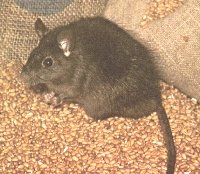 subspecies:
rattus
Linnaeus; alexandrinus Geoffroy; rufescens Gray; ?frugivorus
Rafinesque
subspecies:
rattus
Linnaeus; alexandrinus Geoffroy; rufescens Gray; ?frugivorus
Rafinesque
Black Rat, Ship Rat
maltese: Gurdien/Far iswed
status: Common along the coastline. Species recorded from Malta,
Gozo, and Comino. The species was also recorded from the two superficial
layers of Ghar Dalam Cave dated to Prehistoric and Phoenician - Modern
Times.
Rattus norvegicus (Berkenhout)
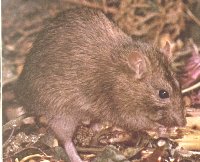 Brown
Rat
Brown
Rat
maltese: Far tal-Kampanja status: Common in countryside.
Species recorded from Malta, Gozo, Comino, and Cominotto. The species was
also recorded from the uppermost superficial layer of Ghar Dalam Cave dated
to Phoenician - Modern Times.
Mus musculus (Linnaeus)
subspecies: brevirostris (Waterhouse); praetextus
(Brants)
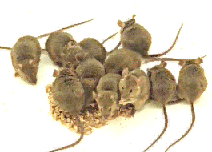 House
mouse
House
mouse
maltese: Gurdien ta' l-Imramma
status: Very common. Recorded from Malta and Gozo. A mouse species
(unidentified) was noted on Comino. The species was also recorded from
the uppermost superficial layer of Ghar Dalam Cave dated to Phoenician
- Modern Times.
Apodemus sylvaticus (Linnaeus)
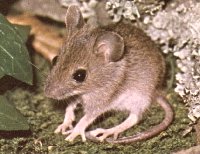 Wood
mouse
Wood
mouse
maltese: Gurdien tar-Raba
status: Found in open countryside. Recorded from Malta in the forn
of live specimens, and from Gozo in the form of skeletal remains in Barn
Owl pellets. The species was also recorded from the second superficial
layer of Ghar Dalam Cave dated to Prehistoric period.
Family: GLIRIDAE
Eliomys (Maltamys) gollcheri de Bruijn
status: Described from Pliestocene remains from Mnaidra Gap (Malta).
Eliomys (Maltamys) wiedincitensis Zammit Maempel & de
Bruijn
status: Described from late Pliestocene deposits at Wied Incita
(Malta).
Leithia melitensis Adams
Great Dormouse
status: Described from Pliestocene deposits at Mnaidra Gap, Tal-Gnien
fissure (Mqabba), Benghisa Gap and Wied Incita in Malta.
Leithia cartei Adams
Carte's Dormouse
status: Pliestocene remains from Mnaidra Gap material in Malta.
It has been suggested that this material may have been synonymous with
Eliomys
gollcheiri.
Family: CRICETIDAE
Pitymys melitensis (Bate)
status: Pliestocene remains from Ghar Dalam cave (Malta).
Pitymys pauli Bate
status: Pliestocene remains from Ghar Dalam cave (Malta).
Order: INSECTIVORA
Suborder: EUINSECTIVORA
Family: ERINACEIDAE
Subfamily: ERINACEINAE
Erinaceus europaeus (Linnaeus)
European Hedgehog Maltese: qanfud
status: Repeatedly listed by Maltese naturalists, but not represented
on the Islands. Mistaken identification with Arthechinus algirus
(Lanfranco, 1969).
Arthechinus algirus (Duv. & Lereb)
 Vagrant
Hedgehog
Vagrant
Hedgehog
maltese: Qanfud
status: Common in the countryside, though number are decreasing
with decreasing habitat areas. Recorded from Malta, Gozo, and Comino. The
species was also recorded from the uppermost layer of Ghar Dalam Cave dated
to Phoenician - Modern Times.
Family: SORICIDAE
Subfamily: CROCIDURINAE
Suncus etruscus (Savi)
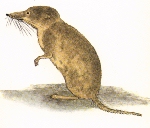 Etruscan Shrew
Etruscan Shrew
maltese: Gurdien ta' Halqu twil
status: Apparently common in the countryside. Reported by most naturalists
as occuring in Malta and Gozo. The species was also recorded from the uppermost
layer of Ghar Dalam Cave dated to Phoenician - Modern Times.
Sorex araneus (Linnaeus)
Common Shrew
status: Only listed once as occurring in Malta, but this was a mistaken
identification. Not presently represented.
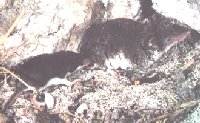 Genus: Crocidura
Genus: Crocidura
The status of this genus in the Maltese Islands is still controversial.
The living forms of this genus have only been recorded from Gozo (never
from Malta). Chromosomal analysis of three specimens of the genus from
Gozo showed a karyotype of 2n = 36 which differs from C. sauveolens
and C. russula, and is similar to the C. sicula (syn. C.
caudata) of Sicily and related to C. canariensis endemic on
the Canary Is. (Vogel et al, 1990). The genus was also represented in all
the layers of Ghar Dalam Cave including the early Pliestocene layers. The
Pliestocene material from Malta have been referred to the fossil species
C.
esui Kotsakis
Crocidura suaveolens Pallas
Lesser White-toothed Shrew; Scilly Shrew
status: Species recorded from Gozo in the form of skeletal remains
in Barn Owl pellets and dead specimen. Also reported as fossil Pliestocene
remains from Ghar Dalam (Pitymys-Cervus layer).
Crocidura russula (Hermann)
Common European White-toothed Shrew
status: Species recorded from Gozo in the form of skeletal remains
in Barn Owl pellets. Also reported from the two superficial layers of Ghar
Dalam Cave dated to Prehistoric and Phoenician - Modern Times. Also reported
from Pliestocene deposits in Malta at Ghar Dalam and Tal-Gnien fissure
- C. cf. russula.
Crocidura cf. leucodon
Bicoloured White-toothed Shrew
status: Reported as fossil remains from Ghar Dalam Cave.
REFERENCE
AL Adams: On a gigantic land tortoise and a small freshwater species from
the ossiferous caverns on Maslta. Quart J. Geol Soc. London, 1877,
33:177-191
DMA Bate: Two new mammals from the pliestocene of Malta, with notes
on the associated fauna. Proc. Zool. Soc. London, 1935, p.247-264
Gav. Guilia: Repertorio di Storia Naturale. Anglo-Maltese: Malta,
1858, p.125,186-187
Giov. Gulia: Elenco dei Mammiferi Maltesi. Il Naturalista Maltese,
1890, 1(1):2-3
GG Lanfranco: Maltese Mammals (Central Mediterranean). Progress
Press: Malta, 1969
C. Savona-Ventura: On the occurrance of Apodemus sylvaticus (Linnaeus)
(Mammalia, Rodentia, Murinidae) in the Maltese Islands with notes on other
Maltese Rodents. Animalia, 1981, 8(1/3):83-86; also correspondence
in Potamon, 1984, 2(13):83
PJ Schembri; SP Schembri: On the occurrence of Crocidura suaveolens
Pallas (Mammalia Insectivora) in the Maltese Islands with notes on other
Maltese shrews. Central Med. Naturalist, 1979, 1:18-21
P. Vogel; PJ Schembri; M. Borg; J. Sultana: The shrew (Crocidura sp.)
of Gozo, a probable survivor of the pliestocene fauna of Mediterranean
Islands. Z. Saugetierkunde, 1990, 55:357-359
G. Zammit Maempel; H. de Bruijn: The Plio/Pliestocene Gliridae from
the Mediterranean Islands reconsidered. Proc. Koninklijke Nederlandse
Akademie, 1982, B 85(1):113-128

 subspecies:
rattus
Linnaeus; alexandrinus Geoffroy; rufescens Gray; ?frugivorus
Rafinesque
subspecies:
rattus
Linnaeus; alexandrinus Geoffroy; rufescens Gray; ?frugivorus
Rafinesque
 Wild
Rabbit
Wild
Rabbit
 Brown
Rat
Brown
Rat
 House
mouse
House
mouse
 Wood
mouse
Wood
mouse
 Vagrant
Hedgehog
Vagrant
Hedgehog
 Etruscan Shrew
Etruscan Shrew
 Genus: Crocidura
Genus: Crocidura